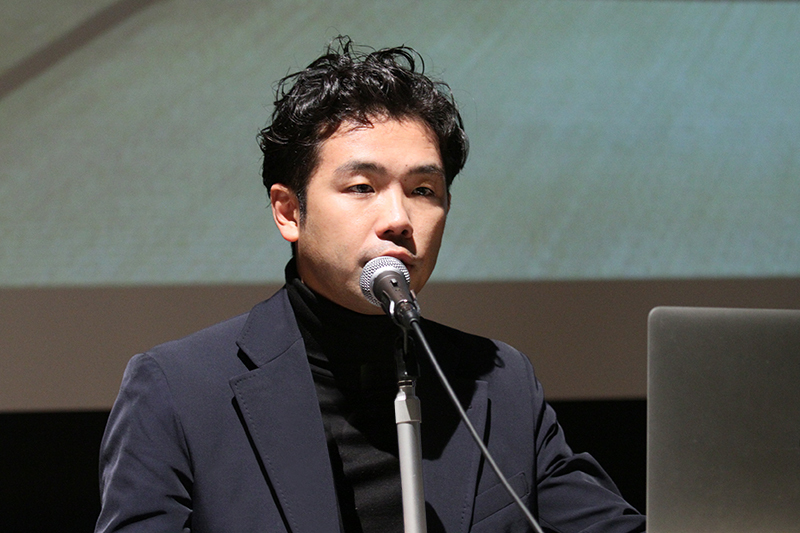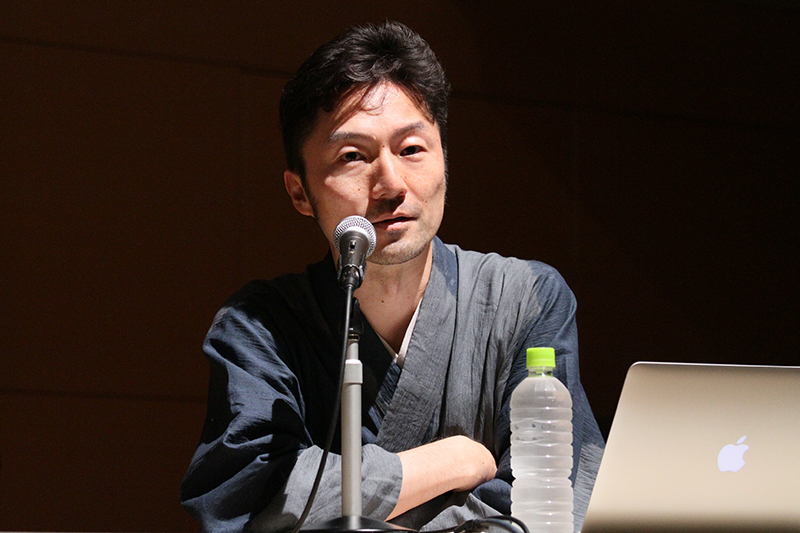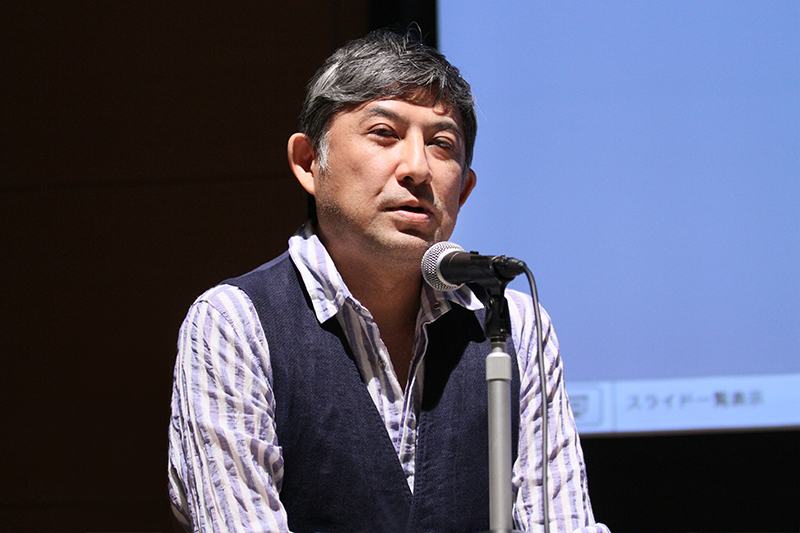After a decade of overseas assignments, Ryo Kagami of Dentsu Inc. Kyoto branch launched the "GO ON" project in 2012. This initiative, involving six traditional craft companies, aims to communicate the new value of Japanese traditional crafts. The new brand "Japan Handmade," born from this project, is now gaining attention, having been well-received in Milan and Paris. This time, we welcome Makoto Hosoo, the 12th-generation head of the Nishijin-ori weaving house "Hosoo," who has been advancing the project alongside Mr. Kagami, and Kotaro Okazaki of Sonar, who serves as Mr. Kagami's strategic advisor. Together, they will introduce their vision for the future of Japanese tradition and their plans to launch initiatives from Kyoto to the world.

(From left) Sonar's Kotaro Okazaki, Hosoo's Masataka Hosoo, Dentsu Inc.'s Ryo Kakamigi
Communicating the Value of Kyoto's Traditional Crafts to the World
Kakami: Today, I'd like to discuss with Mr. Masataka Hosoo, the 12th head of Hosoo, and Mr. Kotaro Okazaki from Sonar, a specialized account planning company, what the value of tradition is and how we can connect that tradition to the future.
Five years ago, I transferred from an overseas assignment to Dentsu Inc. Kyoto office. There, I was deeply moved by the "Kyoto culture" I encountered. Learning that Kyoto's traditional industries had significantly shrunk over the past 20 years, I wanted to help share their appeal overseas. So, I launched the GO ON project with the young masters of six traditional craft companies.
This initiative provides traditional craft techniques and materials to domestic and international companies and creators, aiming to generate unprecedented new value. Among them, Mr. Hosoo has been pioneering efforts even before GO ON's formation, such as collaborating with the overseas interior and fashion industries.
Hoso: Nishijin textiles boast a 1,200-year history. Especially during the 1,000 years when Kyoto was the capital, their beauty was relentlessly pursued as a symbol of power for the imperial court and nobility. It wasn't until after the war that Nishijin textiles became accessible to everyone, as they are today. Eight years ago, I launched an internal venture to market Nishijin textiles as a "material" to overseas markets.
For example, the luxury brand Christian Dior uses Nishijin textiles for wallpaper and chair upholstery in its stores across 100 cities worldwide, including Ginza. Furthermore, Chanel, Bulgari, Louis Vuitton, and domestically, The Ritz-Carlton and Mikimoto Jewelry use them for curtains and cushions.
We've also collaborated with contemporary art and biotechnology. With Panasonic, we're developing wearable textiles featuring speakers that only produce sound when touched, utilizing the electrical conductivity of "Haku" fabric—a weave incorporating gold and silver threads.
Kakami: Even before starting GO ON, you were already collaborating with successors of traditional crafts on these challenges, right?
Hoso: That's right. I never intended to take over the family business; I was a musician for a long time. Eight years ago, I decided I wanted to transform traditional crafts into a creative industry and took over my family's Nishijin-ori weaving business.
For 1,200 years, Nishijin-ori focused solely on the domestic market, so people worldwide know almost nothing about its techniques, materials, or stories. I saw this as a huge opportunity if we changed our perspective.
So, I tentatively exhibited at the Milan Salone for the first time. Naturally, it didn't go smoothly. But then I glanced over and saw other Japanese people struggling just as hard. Those are the members of GO ON today.
The world of traditional crafts has very few horizontal connections. So, while I knew their names, I hadn't met them personally. But learning that people of my generation were challenging themselves overseas with similar aspirations led us to discuss changing the very nature of traditional crafts together.
Taking Japanese sensibilities as our weapon to go global
Kakami: As I listened to their stories, their passion resonated with me, and I wanted to become part of that grand dream.
GO ON's concept formalized the approach Mr. Hosoo was pursuing at the time: exporting Nishijin textiles overseas as raw materials. In other words, it's about deconstructing traditional crafts not as finished products, but as techniques, materials, and stories, then integrating them into other industries.
We've continued building business plans from this concept, raising funds, developing products, and expanding overseas. Initially, we didn't know how to do this, so we enlisted Mr. Okazaki's help. I distinctly remember him telling us back then, "We have to change the rules."
Okazaki: I believe I explained then that if we placed creations born from the rich sensibilities of the Japanese people onto the global platform, overseas companies and creators would never be able to leave it.
Kakamigahara: Exactly. We described this as "sneaking in" and adopted the slogan "GO ON: The Creative Unit That Sneaks In."
Okazaki: Our reference was Swarovski, famous for crystal glass. They started as a machine shop cutting glass using Alpine water power, then developed and patented technologies like cut design and applying solutions to create iridescent sparkle. Evolving as a brand, they've reached their current status. Their finished products, as Swarovski, permeate the worlds of art and culture, appearing in Hollywood films and Academy Awards decorations.
In fact, the true source of Swarovski's business isn't glasswork. It's an adhesive that bonds permanently to the back of flat stones. It's this adhesive technology that made Swarovski usable worldwide.
The person attempting to execute this in Kyoto is Mr. Hosoo, who broke free from the confines of kimono and obi within Nishijin weaving. I believe shifting your perspective even slightly can drastically change the rules.
Hoso: When I first met Mr. Okazaki, I only understood about 1% of what he said (laughs). But what he said stuck with me.
Mr. Okazaki said, "Few countries have distinct seasons like Japan, and Kyoto has cultivated a culture of celebrating them for over 1,000 years. That is its greatest strength."
Hearing that, I truly thought, "That's absolutely right." For example, even when we say "white," Japan has many different shades of white, each with its own name. We use them appropriately according to the changing seasons, incorporating them into kimono patterns or composing waka poems about them.
Japanese people possess this sensitive DNA and are constantly trained to perceive it. Mr. Okazaki taught me that this is our greatest weapon.
Kakami: Just the other day, I was deeply moved by Hosoo Residence, the lodging facility Mr. Hosoo recently opened. It truly embodies Kyoto's unique sensibility of the four seasons.
Hoso: We renovated a roughly 100-year-old Kyoto townhouse into a hotel. We employed traditional plastering techniques like banchiku from the Asuka period and laid white gravel throughout the garden, drawing its reflected light into the rooms. The dim interior heightens sensitivity to brightness.
This is similar to the earlier discussion about color. In the past, Japanese people could perceive changes in light even in environments with less than one lux, like moonlight. This inn is designed to let guests experience that worldview.
Kakami: Before the Hosoo Residence, there was the showroom attached to the Nishijin-ori weaving workshop, right? Now, many guests visit from overseas.
Hoso: That space is also a renovated Kyoto machiya townhouse, with the oldest room dating back 200 years.
Today, luxury travelers from around the world visit Kyoto by private jet. They are drawn to the worldview embodied by traditional crafts. That's why we transformed the workshop into a showroom. Tourism trends are shifting now, with craft tours becoming increasingly popular.
Kakami: To expand on what Mr. Hosoo is doing, we also launched the "Beyond KYOTO" project, a concierge service that offers tours of "craft production sites" that are usually off-limits.
*Continued in Part 2
You can also read the interview here on AdTie!
Planning & Production: Dentsu Live Inc. Creative Unit, Creative Room 2, Aki Kanahara










